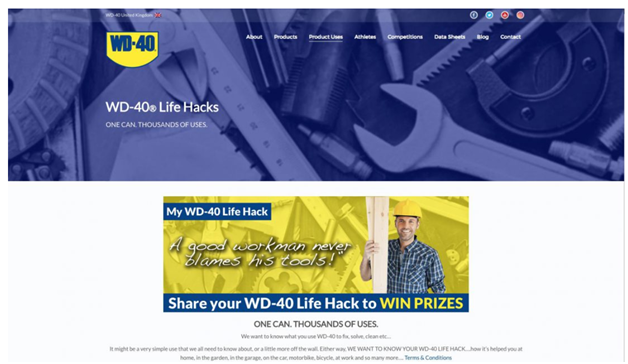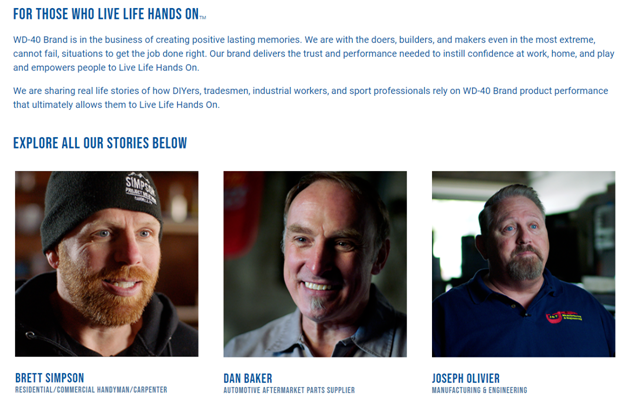Never get stuck! How WD-40’s simple marketing strategy made it into a household name [Monday Marketing Marvels]

Over the years, we have seen numerous innovations and changes to the products we use everyday.
Every year, we see companies churn out updated models and introduce new brands to the market in order to attract more customers.
While numerous companies have followed this trend, there are also some that have focused a great amount of time and effort to keep a single product relevant and effective as it was when first introduced.
This is what the WD-40 Company has done for six decades.
Founded in 1953 as the Rocket Chemical Company in San Diego, California by technicians Cyril E. Irving, Norman Roulette, and Robert Roulette, their first goal was to create a Water Displacement formula for the aerospace industry.
This formula aims to prevent missiles and aircraft from rusting, which is a common aeronautics maintenance problem. The development of the formula was very challenging, with the technicians facing roadblock after roadblock before finding the ideal composition in their 40th attempt (hence the name WD-40).
The first user of the product was aerospace company Convair, which successfully protected their Atlas ballistic missiles from rusting. In fact, it was so effective that their employees would sneak out cans of the formula to use at home!
By 1958, the product was sold to the public for the first time.
Three years later, they began packaging them in aerosol cans, helping them become the iconic household name that we know today.
The company also renamed itself to the WD-40 Company in 1969.
The success of the product was due to its incredible versatility, with hundreds of documented uses, ranging from cleaning metal tools, a lubricant for parts, and as a quick dirt remover. The WD-40 Company’s marketing strategy also played a huge role in helping it reach more companies and households across the world.
Their strategy was simple, yet very effective: market WD-40 as a “multi-use” product. Instead of positioning themselves in a specific industry and targeting one group of people, the company decided that they would be able to sell more cans and reach more customers by promoting it as something that people can use for almost anything, anywhere.
According to current CEO Garry Ridge:
“[Positioning] ourselves as a multiuse product… means we can go anywhere we want. You can buy WD-40 in an automotive store, a hardware store, a grocery store, a drugstore.”
Their marketing campaigns are also structured in a similar manner, highlighting the many uses of the product. One notable example is the WD-40 Life Hacks campaign for their UK branch. It was a social media campaign that encouraged Facebook users to create videos of them using the product and share it to other people on the platform.

Another campaign that they also launched was called Live Life Hands On. It featured and shared the stories of workers and professionals using the product and how it has helped them in different situations.

So many people are loyal to buying and using WD-40. It can keep items and equipment clean, it can strengthen surfaces, and loosen up parts and machinery.
WD-40 was designed to solve a common industry solution. In the end, it became an increasingly versatile product that performed as promised, gaining more and more customers over the decades.
These campaigns and strategies have helped the WD-40 company generate high revenue numbers over the years, reporting over USD 423.4 billion in 2019.
2018 – USD 408.5 billion
2017 – USD 380.5 billion
WD-40’s Earning Power: Valens Research vs. As-reported numbers
WD-40 makes for a great case study that we come back to regularly. One great reason?
The company has proven itself to be a phenomenal earning power generator.
So, how well has WD-40 been growing its business in the past years?
The research doesn’t lie—nor do the results. Earning power (the blue bars) continues to show results much higher than what traditional databases show.

The blue bars in the chart above represent WD-40’s earning power (Uniform Return On Assets). These numbers have been positive, going over 40% ten times for the past 16 years.
The global ROA average is just 6%
The orange bars are the company’s as-reported financial information. If you relied on these numbers, you won’t see the 35% adjusted ROA (return on assets, a measure of earning power) for 2019. You’d just see the company report half of that, at 17% as-reported ROA.
That’s what you’ll see in Yahoo Finance, Google Finance, and most other databases.
The company’s stock price also performed better than the rest of the stock market over the decade, which we can see in the blue line in the chart below. Their returns have been well above the market.

The numbers show that they are doing well and making a profit.
Consistency and quality are two key elements that help make a great product. WD-40 has applied these elements to their product execution for over six decades.
This helped them gain generations of loyal customers, as the company delivered by providing an effective and versatile product that can be used for different kinds of cleaning and maintenance.
Their versatile and dynamic secret formula, combined with a simple yet robust marketing strategy, has helped them remain one of the world’s top-selling products.
About The Dynamic Marketing Communiqué’s
“Monday Marketing Marvels”
Too often, industry experts and the marketing press sing the praises of some company’s marketing strategy.
…Only for the audience to later find out that their product was a flop, or worse, that the company went bankrupt.
The true ROI in marketing can’t be separated from the business as a whole.
What good is a marketing case study if one can’t prove that the company’s efforts actually paid off?
At the end of the day, either the entire business is successful or it isn’t. And the role of marketing is always paramount to that success.
Every Monday, we publish a case study that highlights the world’s greatest marketing strategies.
However, the difference between our case studies and the numerous ones out there, is that we will always make certain that the firm really did generate and demonstrate earning power worthy of study in the first place (compliments of Valens Research’s finance group).
By looking at the true earnings of a company, we can now rely on those successful businesses to get tips and insights on what they did right.
We’ll also study the greatest marketing fails and analyze what they did wrong, or what they needed to improve on. We all make our mistakes, but better we learn from others’ mistakes—and earlier, rather than later.
Hope you found this week’s marketing marvel interesting and helpful.
Stay tuned for next week’s Monday Marketing Marvels!
Cheers,
Kyle Yu
Head of Marketing
Valens Dynamic Marketing Capabilities
Powered by Valens Research
www.valens-research.com




